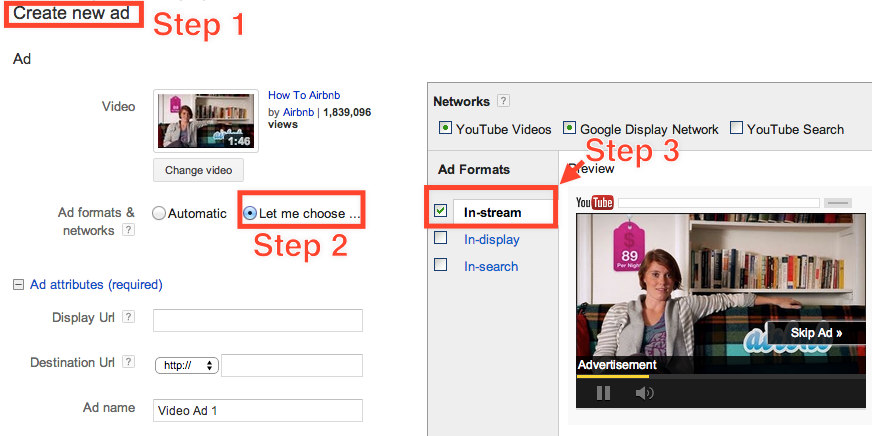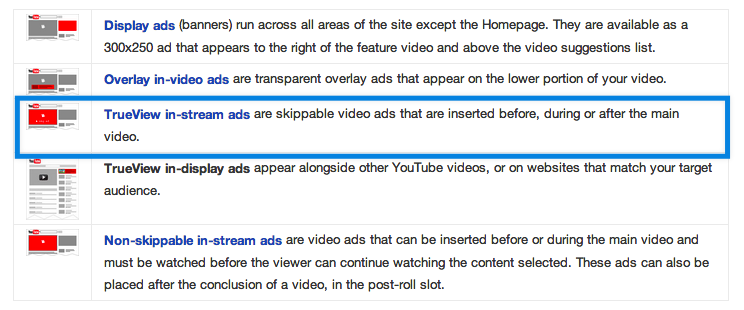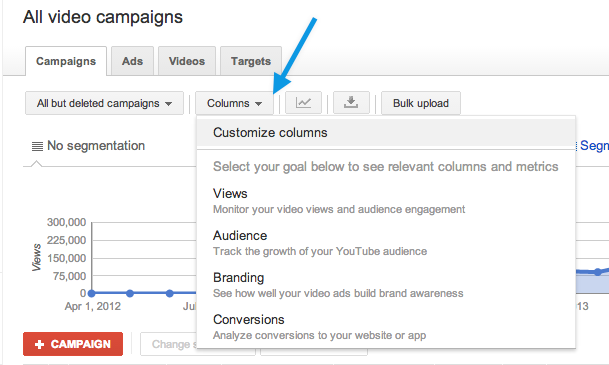I kept seeing Team Treehouse ads on YouTube and was curious how they were performing. So I got introduced to Eric who used to work at Treehouse and did all their YouTube advertising. He was very generous to share below what exactly worked for him with YouTube advertising. A channel that is massive and largely untapped by small advertisers. Take it away Eric…
—————————————————————————————————————
As a marketer, I’m always looking for the next scalable, cost-efficient channel to acquire customers. Easier said than done, right? How often do you stumble across a Google or Facebook to advertise on? Not too often.
In fact, there are only a handful of internet/software services with over 1 billion monthly active users. Just look at this chart:

Above, we can see that there’s one heavily under monetized platform that just makes sense for advertisers – YouTube.
In the past, I was fortunate enough to see some traction with YouTube ads, but there wasn’t a lot of focus on it because it looked expensive. I eventually decided to take a deeper dive and spent a $50,000 in one month and made almost no money back. Not a good start.
However, the second and third month proved to be different. We were paying a few cents per view and actually generating real click through conversions at an acceptable cost per acquisition (CPA). We’re talking CPAs as low as $5 for paying customers that have a lifetime value of roughly $250. Throw in the branding aspect of video advertising and you have a real winner.
For one B2B client, they went from acquiring 0 users to 400 users per month in three months. Their target CPA was $30 less than what they were aiming for! With a customer lifetime value of $150, that’s another $60,000 a month for them.
- Here’s an interesting stat that reveals the opportunity within YouTube: Over 1 billion unique visitors a month. ComScore reports that over 89 million people in the U.S. alone are going to watch 1.2 billion online videos today.
In this post, I’m going to share some key insights I found with YouTube advertising so you don’t need to look goofy spending $50,000 like I did. It’s also worth noting that we didn’t spend $50,000 to make $100. If you want to start your own campaign you can use the tips below with a much smaller budget. $50/day is a good place to start so you can collect data. Once you start seeing conversions double down on what works.
Let Me Show You How To Get Started
Step 1: Create Your Video Creative
Here’s a great example from Treehouse:
3 Key Elements for Every Video Ad:
- Video duration at ~75 seconds.
- Quality. If you produce a low quality video, how do you think that’ll reflect on your brand? See below for examples of quality.
- Experiment with new video creatives at least once a month.
A video like the one above can be done by a company like Sandwich Video. They’ve done videos for companies like Airbnb, Warby Parker, eBay and more.
Typically, creatives can cost anywhere from as low as $5,000 to $100,000. It all depends on what you’re looking for.
If you’re up for more animated videos, I highly recommend Demo Duck or Switch Video.
Make sure your creative gives your viewer a reason NOT to click the ‘Skip Ad’ button at the 5 second mark. Be inspirational, like the Treehouse creative or somewhat quirky like the Crazy Egg video.
Things to do before making your creative:
- Look at your competitors to see what they’re doing. Then see how you can differentiate yourself or even steal from them.
- Define the action you want your viewer to take after viewing.
- Minimize waste. Keep your video short and to the point. Remember, you have 8 seconds to hold your viewer’s attention.
Step 2: Ad Formats – Focus on TrueView
The tests that I’ve run in the past with different companies have all shown me that TrueView in-stream ads are the way to go.

Let’s go over the types of ad formats available to you:

As mentioned earlier, the beauty of TrueView is that you aren’t charged if:
- Your video is skipped
- The viewer watches less than 30 seconds of the video
- The viewer doesn’t finish a video that’s less than 30 seconds.
I’ve found that in-search ads are significantly more expensive and do not generate as much volume.
Step 3: Well Defined Targeting Groups Are Super Important
Targeting groups can be found under the ‘Targets’ tab in each video campaign:

Similar to ad groups, targeting groups are exactly what they say they are – they tell YouTube what to target specifically. For a quick refresher, ‘ad groups’ are: A set of keywords, ads, and bids you manage together, in order to show ads to people likely to be interested in them.
Keys to success with targeting:
- The more targeting options you add, the tighter your targeting becomes. I’d suggest going with only 2-3 targeting options max for each targeting group.
- Label your targeting groups accordingly so you don’t get lost. For example, if you’re targeting web designers and only focusing on in-stream ads, you can name the targeting group ‘Web Designers – in-stream only’.
- If you’re using display keywords, make sure you theme the campaign. For example, if I want to target people that are looking for ‘web design tutorials’, I’d focus on keywords like:
○ web design tutorial
○ web design for beginners
○ learn web design
○ learn web design online
○ etc. until I have 20 keywords max.
- Continually remove irrelevant placements and add negative targets. Negative targets are places you do NOT want your ads to show. For example, if you were selling Rogaine, would you want it to show in children’s videos or women’s makeup videos? Probably not.
![]()

Step 4: Campaign Settings To Pay Attention To
I highly recommend segmenting your campaigns by theme and even countries in some cases. For example, if I wanted to target web designers in countries that mainly speak English, I might put ‘Web Design – US/AU/CA/UK’.
Here are the settings I typically like to go with:

- Delivery Method – you have the option of going with ‘Standard’ which evenly spaces out your ads over the day or ‘Accelerated’. If you have a bigger budget and want to collect data faster, I recommend going with ‘Accelerated’. If you want to go slow and steady, ‘Standard’ is the way to go.
- Languages – make sure you choose the right one.
- Ad scheduling – you can day part if you wish. For this particular campaign I’ve chosen to show it all days and hours because conversions have been fairly consistent.
- Ad rotation – since I have different creatives/copy right now, I want to be rotating my ads evenly to A/B test. Your other options are to optimize for conversions or views. I personally like rotating my ads initially because I start with a few creatives. Once I feel that the campaign is reaching a point where I’m seeing diminishing returns, I’ll optimize for conversions.
- Frequency capping – this one is important. You absolutely do not want to be the company that hits people with 10 of your ads in the same day. It’s a horrible experience. I like to keep this at 1 usually. This means my ad will only show once to a viewer per day.
Step 5: One YouTube Bidding Tip To Remember
If there’s any tip you need to pay attention to from this post, it’s this one. YouTube advertising conveniently rolled all of their bidding per ad format into one bid. Don’t let that trick you.
There’s a way around that:

After you click on ‘Customize bids per format’, you’ll be presented with more bidding options:

In this case, if I’m doing both in-display and in-stream ads and I care more about in-stream, I’ll just reduce my in-display bid. Better yet, you might create two completely different ad campaigns and have one ad focus on in-display and one focus on in-stream. Generally, bid amounts vary per niche but starting at roughly $.15 and then adjusting according to what Google gives you is good.
It takes a little more work but it’ll give you better CPAs (cost per acquisition) in the long run.
As you continue to adjust your bids, there’s a healthy view predictor that shows how many views you might get based on your current bids:

YouTube will also let you know if your targeting group is too narrow which can be helpful in some cases.
My tip here is to adjust the bids until you get a satisfactory projection and then give it a test. Personally, I like to see at least 4,000 predicted views a day. If on any given day your views drop considerably, you’ll know it’s because you need to readjust your bids again. I recommend you monitor your view amounts on a weekly basis.
Step 6: Make Your Dashboard More Relevant
To change the metrics that show up in your dashboard view, click on the ‘Columns’ button:

The metrics I like to add are:
- Converted views – these are your click through conversions.
- Cost/converted view – your cost per acquisition.
- Impression share – what percentage of available impressions am I taking up? If I’m at <10%, I know there’s a lot of room to grow.
- Conversion rate – keep in mind this is conversions divided by views so this is a lower number. Sometimes it’s easier to divide converted views by Website Clicks.
- Website clicks – number of people that clicked your add and went to your site.
- Video played to: – this tells me how engaging my videos are.
Here’s how it looks:

So how did I make my first $100 with YouTube advertising?
Initially, I was hesitant about using YouTube because of all the talk about video ads being great for branding (which I didn’t care about). But I still thought it was worth a test – that’s the key mindset you need to have going into these. You can’t expect miracles to happen overnight and you can’t expect anything to happen if you don’t have the courage to spend some money.
After playing around with targeting that I thought made sense, I ran my ads for about 14 days before registering my first conversion.
Here are some changes I had to make during my first 14 days:
- Created a few targeting ‘themes’. For example, if I was selling a truck product, I’d think about targeting relevant conferences, how to videos, competitors, and other related products. Keep in mind that initially, you want to start with 2-4 themes. That is, unless, you have a 6 to 7 figure budget to test.
- Searched for traction and eliminated ruthlessly. My goal was to find just one targeting theme that worked. Once I did, I paused the other groups and focused on optimizing one group.
- Made sure I was paying attention to my daily bids. There were a lot of fluctuations and some days I would find myself getting no impressions because I was getting heavily outbid.
From there, I shut down my other campaigns and focused on just one until I could refine it. Then I poured more money into it and that’s when it really started to take off in the second month.
In short, I found some traction, focused on it, started to profit, and then expanded into other areas. That formula has served me well for years 🙂
Conclusion
Marketers are just starting to recognize YouTube ads as a profitable and scalable channel in their marketing toolbox. The ones who take advantage of it will get better rates before it will start to get very saturated in the next year or two. Armed with this post, you’ll be able to avoid making the same mistakes I made while testing. Go give it a shot and tell me how it goes for you! Good luck.
Eric Siu (@ericosiu) is the CEO of digital marketing agency Single Grain, which does YouTube advertising, Facebook advertising and content marketing. He also video interviews entrepreneurs like Noah Kagan, Rand Fishkin and more on his blog, Growth Everywhere.

22 responses to “YouTube Marketing in 6 Steps: How to Run Your First Campaign”
This is really great article . Really good information share with us.
Thank you very much.
I use adwords video to remarket! My target audience consumes a lot of video content and as such we are evolving a robust video strategy.Working with video campaigns can be a lot of fun if you have your audience targeted well. Expensive if you don’t.
Great tips Eric. 0.03 CPV is a very cost effective approach to advertising.
Great article Eric. Youtube is one channel that a lot of marketers avoid. If you really feel like branching out of your comfort zone, try TV advertising. Yogiyo, a Korean startup ran a TV campaign which resulted in a huge success. Their competitor (a startup) didn’t do any marketing, and you can probably guess what happened.
This is a good and honest tutorial – thanks for taking the time to share your experiences…good and bad 😉
I think this is the best article on YouTube campaign planning and optimizing available online right now. Yes, even I feel that in-stream ads are the best.
Thank you for sharing the info with us.
Really loved this post Eric. Have never ever considered Youtube to be a possible channel but this made me rethink the opportunities. Thanks for getting this post for us readers Noah!
Wow, never thought about YouTube as a possibility for marketing. Interesting insights to be found here, but i guess that right at this time, my budget for playing around with it would be too small. My next plan would be to try out facebook ads to generate some revenue. We´ll see how that works out. Thanks for sharing, eric!
Thanks for having him, Noah
Saludos!
Great article/tutorial. We all have a pool of multimedia greatness near us. You can approach tech schools, tell them what you want and the students can produce your video. Imagine having a class of 12 students, 3 teams, doing a real world project. They get compensated by you and before they graduate they have a resume builder. Everyone wins, provided you’re not a cheap bastard, and you might find a potential, long term addition to your business.
Fantastic idea!
Fantastic article Eric! Will definitely be investigating these. Noah – your blog is awesome!!
Thanks Sam!
I never ever tried Youtube ads, I ought to give it a try, the only thing that keeps me back is the video production itself.
Thanks Noah, great article. How would one apply A/B split testing with banner Ad’s in real time streaming on You Tube. Any tools available for this?
Right now the only option is using the AdWords interface (as far as I know)
Great article. I like how you break it down into and easy to follow tutorial. Do you have any tips on DIY video creative creation as well? For marquee pieces I’m inclined to go with an external vendor, however at some point we’ll want to test variations etc… like very other ad format, and 3rd parties won’t be economically feasible anymore. Any software/equipment you suggest? Or even videography courseware?
Thanks Jason. I think a video creative article would be a welcome addition to Okdork. We should bug Noah to find someone to do it.
Awesome summary Eric!
I’ve been wanting to test YouTube In-Stream ads for a while after hearing Brian Carter say that YouTube is currently one of the best advertising values around.
The biggest hurdle for myself and many of my consulting clients that there’s a big cost to create the video creative.
Hi Aaron, although the costs are high, we can generally do them for less than the low-ball $5K to high-ball $100K mentioned in this article. And, ours are every bit as good (All bragging aside! 😉 Should you or your consulting clients want/need some help, just let me know and we can chat and show some examples of work we’ve done in the past.
We should talk Zach 🙂 eric at singlegrain
Thanks Aaron! Sounds like Zach has a potential solution for you 🙂
Great and insightful article Noah. I find these types of article very informative and makes me think of other ideas that I’ll perhaps use as I continue through “How to Make a $1000 business”
Dave